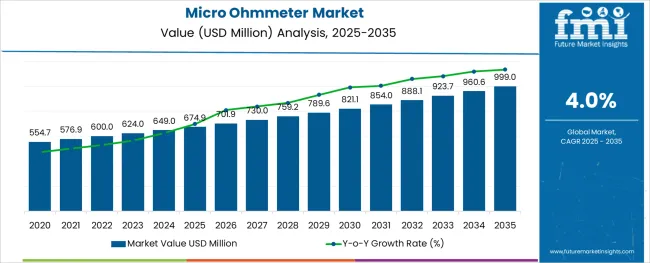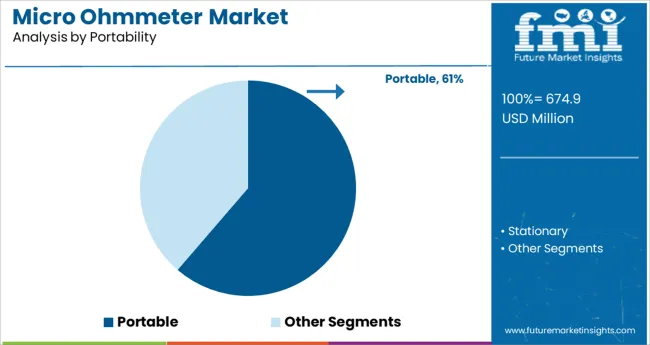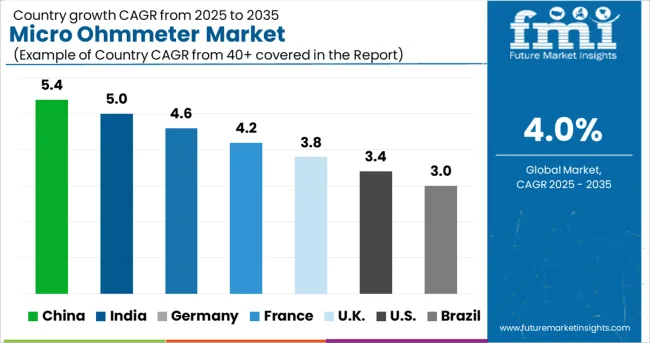The Micro Ohmmeter Market is estimated to be valued at USD 674.9 million in 2025 and is projected to reach USD 999.0 million by 2035, registering a compound annual growth rate (CAGR) of 4.0% over the forecast period.

The micro ohmmeter market is expanding steadily, driven by the increasing need for precise low-resistance measurements across various industries. Accurate measurement of electrical resistance is critical for ensuring the safety and reliability of electrical equipment. The rising adoption of portable testing devices has been favored due to their ease of use and flexibility in field operations.
Laboratories and maintenance teams rely heavily on micro ohmmeters for quality control and equipment diagnostics. Technological advancements in resistive test modes have improved measurement accuracy and speed, enabling better fault detection.
Additionally, sales channels focused on new equipment purchases have grown due to ongoing infrastructure upgrades and industrial maintenance programs. With expanding applications in electrical testing and manufacturing, the market outlook remains positive. Segmental growth is expected to be led by portable devices in portability, resistive mode in test methods, and laboratories as the key application area.
The market is segmented by Portability, Test Mode, Application, and Sales Channel and region. By Portability, the market is divided into Portable and Stationary. In terms of Test Mode, the market is classified into Resistive, Inductive, and Repetitive. Based on Application, the market is segmented into Laboratories, Power Stations, Commercial Use, Industrial Use, and Other Applications. By Sales Channel, the market is divided into New Sales and Repair/After Sales. Regionally, the market is classified into North America, Latin America, Western Europe, Eastern Europe, Balkan & Baltic Countries, Russia & Belarus, Central Asia, East Asia, South Asia & Pacific, and the Middle East & Africa.

The Portable segment is projected to hold 61.3% of the micro ohmmeter market revenue in 2025, maintaining its dominance in portability preferences. This segment’s growth has been driven by the demand for lightweight and compact devices that facilitate on-site testing in various environments.
Portable micro ohmmeters allow technicians to conduct quick and accurate resistance measurements without the constraints of fixed setups. The convenience of battery-operated instruments that can be transported easily between locations has made this segment popular in field maintenance and quality assurance.
Additionally, increasing industrial safety regulations have encouraged frequent on-site electrical testing, further supporting portable device adoption. The Portable segment’s practicality and efficiency are expected to sustain its leading position in the market.

The Resistive test mode segment is expected to contribute 48.7% of the micro ohmmeter market revenue in 2025, securing its position as the leading test method. Resistive testing is fundamental for evaluating the electrical resistance of components and connections, making it essential for ensuring system integrity.
Its accuracy and reliability have made it the preferred mode for routine maintenance and diagnostics in electrical systems. The resistive test mode enables detection of issues such as loose connections and contact resistance that can cause equipment failure or energy losses.
This segment’s growth has been supported by improvements in measurement resolution and noise reduction technologies. As electrical systems grow more complex, the resistive test mode remains critical for effective condition monitoring.

The Laboratories segment is projected to account for 27.9% of the micro ohmmeter market revenue in 2025, remaining a key application area. Laboratories require precise and reliable instruments for product testing, research, and development across multiple industries including electronics and electrical equipment manufacturing.
The segment has grown with increasing demand for quality assurance and compliance testing. Laboratory environments favor micro ohmmeters that offer high accuracy and repeatability under controlled conditions.
The expansion of R&D activities in emerging technologies has also contributed to higher instrument utilization in labs. As innovation continues to drive industry standards, laboratories will maintain their role as critical end users of micro ohmmeters.
According to the FMI’s recent research study, the global market for micro ohmmeters is expected to grow at a healthy rate throughout the forecast period. Micro ohmmeters are also gaining popularity in a variety of applications. The rapid expansion of laboratories reflects the widespread use of micro ohmmeters.
Micro ohmmeters are expected to be in high demand in the coming years from applications such as home and building solutions, commercial use, industrial use, and so on. Micro ohmmeter is expected to grow rapidly during the forecast period. Higher demand for portable micro ohmmeters around the world has prompted the use of micro ohmmeters, driving market growth.
The fact that micro ohmmeters are only used for measuring low resistances is a major impediment to the growth of the micro ohmmeter market. Stringent regulations governing the use of micro ohmmeters are likely to stymie the growth of the micro ohmmeter market. Furthermore, the high cost of micro ohmmeters will stifle market growth.
Developing market such as APEJ is expected to multiply micro ohmmeter throughout the forecast period. Furthermore, with the rapidly increasing use of micro ohmmeter in applications such as power stations, laboratories, and industrial use, among others, the global market for micro ohmmeter is expected to witness healthy growth factors.

According to Future Market Insights, In terms of volume, established market such as Europe is expected to dominate the micro ohmmeter market.

Micro ohmmeter manufacturers are primarily focused on emerging markets in order to generate significant operating revenue. Key market vendors are constantly introducing new micro ohmmeter products. Megger, HV Diagnostics, Extech Instruments, AEMC Instruments, and other key market participants are listed below.
| Report Attribute | Details |
|---|---|
| Growth Rate | CAGR of 4% from 2025 to 2035 |
| Base Year for Estimation | 2024 |
| Historical Data | 2020 to 2024 |
| Forecast Period | 2025 to 2035 |
| Quantitative Units | Revenue in billion, Volume in Kilotons and CAGR from 2025 to 2035 |
| Report Coverage | Revenue Forecast, Volume Forecast, Company Ranking, Competitive Landscape, Growth Factors, Trends and Pricing Analysis |
| Segments Covered | Portability, Test Mode, Application, Sales Channel, Region |
| Regions Covered | North America; Latin America; Europe; CIS & Russia; Asia Pacific excluding Japan; Japan; Middle East & Africa |
| Key Countries Profiled | USA, Canada, Brazil, Argentina, Germany, UK, France, Spain, Italy, Nordics, BENELUX, Australia & New Zealand, China, India, ASEAN, GCC, South Africa |
| Key Companies Profiled | Megger; HV Diagnostics; Extech Instruments; AEMC Instruments |
| Customization | Available Upon Request |
The global micro ohmmeter market is estimated to be valued at USD 674.9 million in 2025.
It is projected to reach USD 999.0 million by 2035.
The market is expected to grow at a 4.0% CAGR between 2025 and 2035.
The key product types are portable and stationary.
resistive segment is expected to dominate with a 48.7% industry share in 2025.






Full Research Suite comprises of:
Market outlook & trends analysis
Interviews & case studies
Strategic recommendations
Vendor profiles & capabilities analysis
5-year forecasts
8 regions and 60+ country-level data splits
Market segment data splits
12 months of continuous data updates
DELIVERED AS:
PDF EXCEL ONLINE
Microfilm Reader Market Size and Share Forecast Outlook 2025 to 2035
Micro-Dosing Sachet Fillers Market Analysis - Size and Share Forecast Outlook 2025 to 2035
Microbial Growth Monitoring System Market Size and Share Forecast Outlook 2025 to 2035
Micro Hotel Market Forecast and Outlook 2025 to 2035
Microwave Source Market Size and Share Forecast Outlook 2025 to 2035
Micro-energy Harvesting System Market Size and Share Forecast Outlook 2025 to 2035
Micro CHP Market Size and Share Forecast Outlook 2025 to 2035
Micro Irrigation System Market Size and Share Forecast Outlook 2025 to 2035
Micro Flute Paper Market Size and Share Forecast Outlook 2025 to 2035
Microcrystalline Cellulose Market Size and Share Forecast Outlook 2025 to 2035
Micro Balances Market Size and Share Forecast Outlook 2025 to 2035
Micro Perforated Films Packaging Market Size and Share Forecast Outlook 2025 to 2035
Microbial Coagulants Market Size and Share Forecast Outlook 2025 to 2035
Microserver IC Market Size and Share Forecast Outlook 2025 to 2035
Microplate Handling Instruments Market Size and Share Forecast Outlook 2025 to 2035
Microsclerotherapy Treatment Market Size and Share Forecast Outlook 2025 to 2035
MicroLED Photoluminescence Inspection System Market Size and Share Forecast Outlook 2025 to 2035
Micro-Scale VFFS Modules Market Analysis - Size and Share Forecast Outlook 2025 to 2035
Microscope Digital Camera Market Size and Share Forecast Outlook 2025 to 2035
Micro Guide Catheter Market Size and Share Forecast Outlook 2025 to 2035

Thank you!
You will receive an email from our Business Development Manager. Please be sure to check your SPAM/JUNK folder too.
Chat With
MaRIA